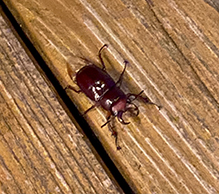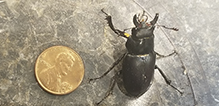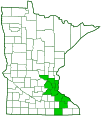reddish-brown stag beetle
(Lucanus capreolus)
Conservation • Description • Habitat • Ecology • Distribution • Taxonomy
Conservation Status |
|
|||||||
| IUCN Red List | not listed |
|||||||
| NatureServe | NNR - Unranked |
|||||||
| Minnesota | not listed |
|||||||
Description |
||
Reddish-brown stag beetle is a relatively large beetle. It occurs in the United States east of the Great Plains and in adjacent Canadian provinces. It is found around decaying logs and stumps in deciduous forests, parks, and neighborhoods with trees. Larvae feed on decaying wood, adults feed on tree sap. The name “stag beetle” refers to the oversized mandibles on some males that resemble deer antlers. Another common name for this beetle is pinching bug. The mandibles look fierce and are used to fight other males over a female. When confronted, it will rear back threateningly with its mandibles open. However, when handled by humans, it can give no more than a mild pinch. Adults are light to dark reddish-brown and ¾″ to 1 7⁄16″ (20 to 36 mm) in length not including the mandibles. The body is robust and elongated. The head and mouthparts are directed forward. The head is large and is not concealed beneath the pronotum. On the male it is slightly wider than the exoskeletal plate covering the thorax (pronotum). The antennae have 10 segments (antenomeres) including the very long basal segment (scape). They are abruptly bent, elbow-like (geniculate), after the scape. The last four segments are expanded sideways, comb-like, into long flattened lobes (clubbed). The clubbed segments cannot be held together. The chewing mouthparts (mandibles) are enlarged and curved inwards. They are not branched. On major males they are greatly elongated, as long as the pronotum. On females and minor males they are shorter. On both sexes the mandibles have just a single tooth on the inner edge. The pronotum is narrower at the rear than the base of the hardened wing covers (elytra). It does not have any grooves, ridges, or projections. The elytra are not grooved or ridged. They appear smooth but are densely covered with very fine punctures. The legs are mostly reddish-brown and are adapted for digging. The third segment of each leg (femur) is yellowish-brown, distinctly lighter than the body and the remaining leg segments. The fourth segment (tibia) of the front leg has distinct, saw-like, large and small teeth. The last part of the leg (tarsus), corresponding to the foot, has five segments. There is a pair of claws at the end of the last segment. The claws are equal in size and are not toothed. |
||
Size |
||
Total length: ¾″ to 1 7⁄16″ (20 to 36 mm) |
||
Similar Species |
||
Smooth stag beetle (Lucanus placidus) is very dark reddish-brown to black. The femurs on the front leg is dark, the same color as the head and body. |
||
Habitat |
||
Deciduous forests, parks, neighborhoods with trees, around decaying logs and stumps. |
||
Ecology |
||
Season |
||
|
||
Behavior |
||
Adults are active at night and are attracted to lights. They make a loud buzzing noise when they fly. |
||
Life Cycle |
||
|
||
Larva Food |
||
Decaying wood |
||
Adult Food |
||
Tree sap |
||
Distribution |
||||
|
Sources |
|||
| 6/28/2022 | ||||
Occurrence |
||||
Common |
||||
Taxonomy |
|||
Order |
Coleoptera (Beetles) | ||
Suborder |
Polyphosphate (water, rove, scarab, longhorn, leaf and snout beetles) | ||
Infraorder |
Scarabaeiformia | ||
Superfamily |
Scarabaeoidea (scarab, stag beetles, and allies) | ||
Family |
Lucanidae (stag beetles) | ||
Subfamily |
Lucaninae | ||
Tribe |
Lucanini | ||
Genus |
Lucanus | ||
Subgenus |
Pseudolucanus | ||
This species was formerly classified as Pseudolucanus capreolus. The genus Pseudolucanus has been demoted to a subgenus of the genus Lucanus. |
|||
Synonyms |
|||
Lucanus dama Lucanus muticus Lucanus trigonus Pseudolucanus capreolus |
|||
Common Names |
|||
pinching bug reddish-brown stag beetle yellow-thighed stag beetle |
|||
Glossary
Elytra
The hardened or leathery forewings of beetles used to protect the fragile hindwings, which are used for flying. Singular: elytron.
Femur
On insects and arachnids, the third, largest, most robust segment of the leg, coming immediately before the tibia. On humans, the thigh bone.
Pronotum
The exoskeletal plate on the upper side of the first segment of the thorax of an insect.
Punctate
Dotted with pits (punctures), translucent sunken glands, or colored spots of pigment.
Scape
In plants: An erect, leafless stalk growing from the rootstock and supporting a flower or a flower cluster. In insects: The basal segment of the antenna.
Tarsus
On insects, the last two to five subdivisions of the leg, attached to the tibia; the foot. On spiders, the last segment of the leg. Plural: tarsi.
Tibia
The fourth segment of an insect leg, after the femur and before the tarsus (foot). The fifth segment of a spider leg or palp. Plural: tibiae.
Visitor Photos |
|||||
Share your photo of this insect. |
|||||
| This button not working for you? Simply email us at info@MinnesotaSeasons.com. Attach one or more photos and, if you like, a caption. |
|||||
CapnDave |
|||||
 |
|||||
Plannine |
|||||
Found this guy knocking on my front door on the evening of June 9th. |
|||||
 |
|||||
MinnesotaSeasons.com Photos |
|||||
|
|||||

Slideshows |
||

Visitor Videos |
|||
Share your video of this insect. |
|||
| This button not working for you? Simply email us at info@MinnesotaSeasons.com. Attach a video, a YouTube link, or a cloud storage link. |
|||
Other Videos |
|||
| Lucanus capreolus Houseplant Hospital |
|||
About
Jul 12, 2017 Slow motion stag beetle |
|||
| lucanus capreolus enjoying some maple syrup 😁 Diana Linley |
|||
About
Jul 11, 2019 |
|||
| Adult female Lucanus elaphus or Lucanus capreolus Nathaniel Long |
|||
About
Jul 21, 201 |
|||


Created: 8/18/2020
Last Updated:
